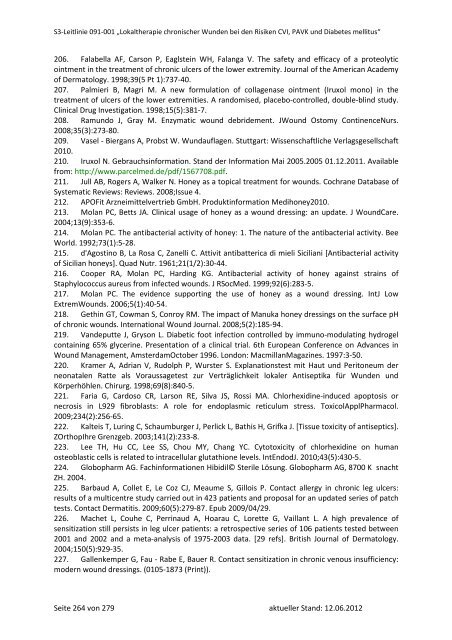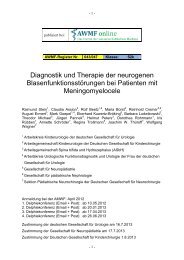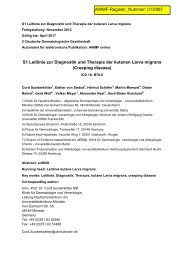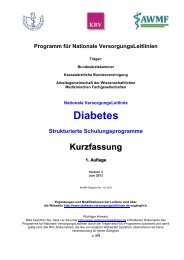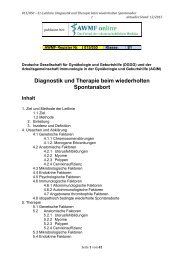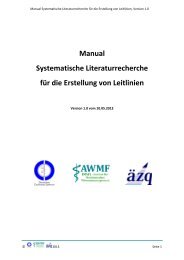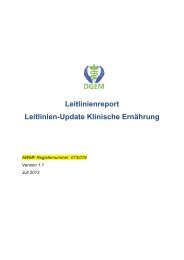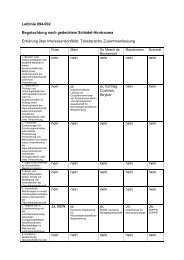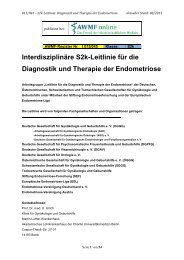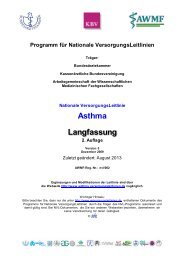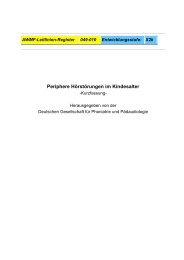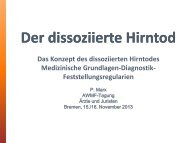Lokaltherapie chronischer Wunden bei Patienten mit den ... - AWMF
Lokaltherapie chronischer Wunden bei Patienten mit den ... - AWMF
Lokaltherapie chronischer Wunden bei Patienten mit den ... - AWMF
Sie wollen auch ein ePaper? Erhöhen Sie die Reichweite Ihrer Titel.
YUMPU macht aus Druck-PDFs automatisch weboptimierte ePaper, die Google liebt.
S3-Leitlinie 091-001 „<strong>Lokaltherapie</strong> <strong>chronischer</strong> <strong>Wun<strong>den</strong></strong> <strong>bei</strong> <strong>den</strong> Risiken CVI, PAVK und Diabetes mellitus“<br />
206. Falabella AF, Carson P, Eaglstein WH, Falanga V. The safety and efficacy of a proteolytic<br />
ointment in the treatment of chronic ulcers of the lower extre<strong>mit</strong>y. Journal of the American Academy<br />
of Dermatology. 1998;39(5 Pt 1):737-40.<br />
207. Palmieri B, Magri M. A new formulation of collagenase ointment (Iruxol mono) in the<br />
treatment of ulcers of the lower extre<strong>mit</strong>ies. A randomised, placebo-controlled, double-blind study.<br />
Clinical Drug Investigation. 1998;15(5):381-7.<br />
208. Ramundo J, Gray M. Enzymatic wound debridement. JWound Ostomy ContinenceNurs.<br />
2008;35(3):273-80.<br />
209. Vasel - Biergans A, Probst W. Wundauflagen. Stuttgart: Wissenschaftliche Verlagsgesellschaft<br />
2010.<br />
210. Iruxol N. Gebrauchsinformation. Stand der Information Mai 2005.2005 01.12.2011. Available<br />
from: http://www.parcelmed.de/pdf/1567708.pdf.<br />
211. Jull AB, Rogers A, Walker N. Honey as a topical treatment for wounds. Cochrane Database of<br />
Systematic Reviews: Reviews. 2008;Issue 4.<br />
212. APOFit Arznei<strong>mit</strong>telvertrieb GmbH. Produktinformation Medihoney2010.<br />
213. Molan PC, Betts JA. Clinical usage of honey as a wound dressing: an update. J WoundCare.<br />
2004;13(9):353-6.<br />
214. Molan PC. The antibacterial activity of honey: 1. The nature of the antibacterial activity. Bee<br />
World. 1992;73(1):5-28.<br />
215. d'Agostino B, La Rosa C, Zanelli C. Attivit antibatterica di mieli Siciliani [Antibacterial activity<br />
of Sicilian honeys]. Quad Nutr. 1961;21(1/2):30-44.<br />
216. Cooper RA, Molan PC, Harding KG. Antibacterial activity of honey against strains of<br />
Staphylococcus aureus from infected wounds. J RSocMed. 1999;92(6):283-5.<br />
217. Molan PC. The evi<strong>den</strong>ce supporting the use of honey as a wound dressing. IntJ Low<br />
ExtremWounds. 2006;5(1):40-54.<br />
218. Gethin GT, Cowman S, Conroy RM. The impact of Manuka honey dressings on the surface pH<br />
of chronic wounds. International Wound Journal. 2008;5(2):185-94.<br />
219. Vandeputte J, Gryson L. Diabetic foot infection controlled by immuno-modulating hydrogel<br />
containing 65% glycerine. Presentation of a clinical trial. 6th European Conference on Advances in<br />
Wound Management, AmsterdamOctober 1996. London: MacmillanMagazines. 1997:3-50.<br />
220. Kramer A, Adrian V, Rudolph P, Wurster S. Explanationstest <strong>mit</strong> Haut und Peritoneum der<br />
neonatalen Ratte als Voraussagetest zur Verträglichkeit lokaler Antiseptika für <strong>Wun<strong>den</strong></strong> und<br />
Körperhöhlen. Chirurg. 1998;69(8):840-5.<br />
221. Faria G, Cardoso CR, Larson RE, Silva JS, Rossi MA. Chlorhexidine-induced apoptosis or<br />
necrosis in L929 fibroblasts: A role for endoplasmic reticulum stress. ToxicolApplPharmacol.<br />
2009;234(2):256-65.<br />
222. Kalteis T, Luring C, Schaumburger J, Perlick L, Bathis H, Grifka J. [Tissue toxicity of antiseptics].<br />
ZOrthopIhre Grenzgeb. 2003;141(2):233-8.<br />
223. Lee TH, Hu CC, Lee SS, Chou MY, Chang YC. Cytotoxicity of chlorhexidine on human<br />
osteoblastic cells is related to intracellular glutathione levels. IntEndodJ. 2010;43(5):430-5.<br />
224. Globopharm AG. Fachinformationen Hibidil© Sterile Lösung. Globopharm AG, 8700 K snacht<br />
ZH. 2004.<br />
225. Barbaud A, Collet E, Le Coz CJ, Meaume S, Gillois P. Contact allergy in chronic leg ulcers:<br />
results of a multicentre study carried out in 423 patients and proposal for an updated series of patch<br />
tests. Contact Dermatitis. 2009;60(5):279-87. Epub 2009/04/29.<br />
226. Machet L, Couhe C, Perrinaud A, Hoarau C, Lorette G, Vaillant L. A high prevalence of<br />
sensitization still persists in leg ulcer patients: a retrospective series of 106 patients tested between<br />
2001 and 2002 and a meta-analysis of 1975-2003 data. [29 refs]. British Journal of Dermatology.<br />
2004;150(5):929-35.<br />
227. Gallenkemper G, Fau - Rabe E, Bauer R. Contact sensitization in chronic venous insufficiency:<br />
modern wound dressings. (0105-1873 (Print)).<br />
Seite 264 von 279 aktueller Stand: 12.06.2012


